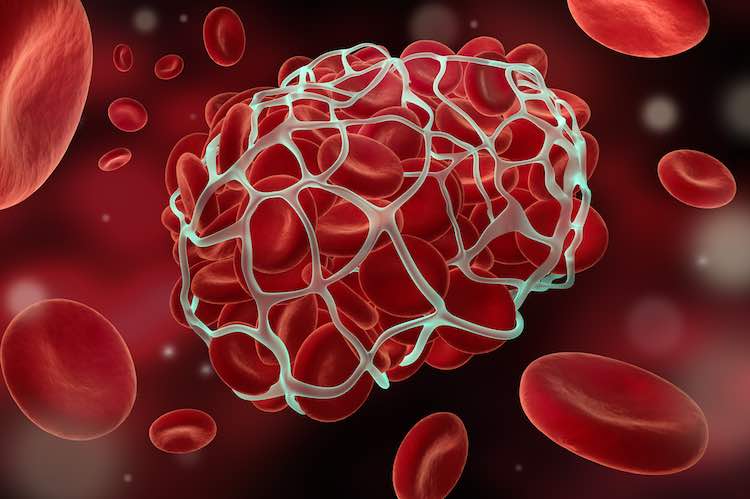Blood Clot
Overview | Possible Causes | Care and Treatment | HOME REMEDies | When to Call the Doctor | References

Overview
Blood clots are gel-like clumps of blood. They are beneficial when they form in response to an injury or a cut, plugging the injured blood vessel, which stops bleeding.
Some blood clots form inside your veins without a good reason and don't dissolve naturally. These may require medical attention, especially if they are in your legs or are in more critical locations, such as your lungs and brain. A number of conditions can cause this type of blood clot.
Possible Causes
Blood clots form when there is damage to the lining of a blood vessel, either an artery or a vein. The damage may be obvious, such as a cut or laceration, or may not be visible to the naked eye. Blood also will begin to clot if it stops moving and becomes stagnant, or in diseases that cause the blood to clot abnormally.
Blood clots in a vein (venous thrombosis) occur when a person becomes immobilized and muscles are not contracting to push blood back to the heart. This stagnant blood begins to form small clots along the walls of the vein. This initial clot can gradually grow to partially or completely block (occlude) the vein and prevent blood from returning to the heart.
Blood clots in an artery (arterial thrombi) occur by a different mechanism. For those with atherosclerotic disease, plaque deposits form along the lining of the artery and grow, which causes the vessel to narrow. This disease process may cause:
- Heart attack
- Stroke
- Peripheral artery disease (PAD)
If a plaque ruptures, a blood clot can form at the site of that rupture and can completely or partially block the blood flow at that point.
Some other causes:
- Blood clots in the heart: In atrial fibrillation, the upper chamber (atrium) of the heart does not beat in an organized manner. Instead, it jiggles, and blood tends to become stagnant along the walls of the atrium. Over time this may cause small blood clots to form. Clots also can form in the ventricle after a heart attack when part of the heart muscle is injured and unable to contract normally. Since the damaged area doesn't contract with the rest of the heart, blood can start to pool or stagnate, leading to clot formation.
- Blood leaking out of a blood vessel: Blood clots can form when blood leaks out of a blood vessel, and this process can be very beneficial because the clot helps stop further bleeding at the site of injury. A few examples of how bleeding is controlled by the body's clotting mechanism are
- Cuts or scrapes
- Broken bones
- Sprains and strains
- Nosebleed
-
Blood clots causing other medical problems: Sometimes, normal blood clotting can cause medical problems because of its location. For example, blood in the urine may occur from any of a variety of reasons (such as infection, trauma, or tumor/cancer), and clots may form over the urethra, the tube that empties the bladder, preventing the bladder from emptying, causing urinary retention.Clot formation in the uterus may cause pain when the clots are passed through the cervix and can lead to vaginal bleeding, either as part of menstruation or as abnormal vaginal bleeding (menorrhagia, dysmenorrhea).
Care & Treatment
Blood clots are treated differently depending on the location of the clot and your health. If you are experiencing symptoms and suspect you may have a blood clot, see a doctor immediately.
There have been many research advances that have improved the prevention and treatment of blood clots. Some current treatments include:
- Anticoagulants - medicine that prevents clots from forming
- Thrombolytics - medicine that dissolves blood clots
- Catheter-directed thrombolysis - a procedure in which a long tube, called a catheter, is surgically inserted and directed toward the blood clot where it delivers clot-dissolving medication
- Thrombectomy - surgical removal of a clot
If you are diagnosed with a venous clot, your doctor may refer you to a hematologist, a doctor who specializes in treating blood diseases. People diagnosed with arterial disease who are at risk for developing a clot in their arteries may have several doctors involved in their care, including a cardiologist (a doctor who specializes in conditions of the heart), a neurologist, and possibly a hematologist.
For some patients, participating in a clinical trial provides access to novel therapies. If diagnosed, you can talk with your doctor about whether joining a clinical trial is right for you.
Home Remedies
To reduce your risk of developing blood clots, try these tips:
- Avoid sitting for long periods. If you travel by airplane, walk the aisle periodically. For long car trips, stop and walk around frequently.
- Move. After you've had surgery or been on bed rest, the sooner you get up and move around, the better.
- Drink plenty of fluids when traveling. Dehydration can contribute to the development of blood clots.
- Change your lifestyle. Lose weight, lower high blood pressure, stop smoking and exercise regularly.
When to Call the Doctor
Seek emergency care if you experience:
- Cough that produces bloody sputum
- A fast heartbeat
- Lightheadedness
- Difficult or painful breathing
- Chest pain or tightness
- Pain extending to your shoulder, arm, back or jaw
- Sudden weakness or numbness of your face, arm or leg
- Sudden difficulty speaking or understanding speech (aphasia)
- Sudden changes in your vision
Consult your doctor if you develop these signs or symptoms in an area on an arm or leg:
- Swelling
- Redness
- Pain
To book online consultation to meet our expert doctor click on the link below






































































































